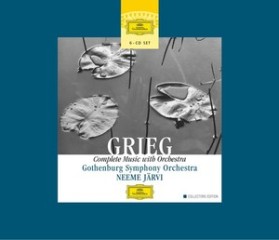Edvard Grieg - Complete Music with Orchestra (2001) CD1
Edvard Grieg - Complete Music with Orchestra (2001) CD1

Piano Concerto In A Minor, Op.16 1.1. Allegro molto moderato 13:04 2.2. Adagio - attacca: 6:18 3.3. Allegro moderato molto e marcato - Quasi presto - Andante maestoso 10:28 In Autumn op.11 4.Andante - Allegro agitato - Allegro marcato e maestoso 11:15 Symphonic Dances, Op.64 5.1. Allegro moderato e marcato 6:54 6.2. Allegretto grazioso 6:02 7.3. Allegro giocoso 6:04 8.4. Andante - Allegro molto e risoluto 12:07 Lilya Zilberstein – piano Gothenburg Symphony Orchestra Neeme Järvi – conductor
This is a gathering together of recordings made over a period of about seven years and covers everything Grieg wrote involving an orchestra in some way. I toyed with the idea of rearranging it to listen chronologically, and so get an idea of Grieg’s development, but few listeners are likely to want to do this and I feel the compilers of sets like this should also be judged on their success or not in making each disc a listener-friendly experience, so I opted for a disc-by-disc account.
CD 1
The ultra-popular works are not really the point in this kind of set so I won’t dwell on the Piano Concerto but it is in fact a very fresh and attractive performance. The performers allow themselves plenty of elbow room for rubatos and rallentandos but the tempi themselves are kept steadier than usual and certain time-honoured exaggerations are avoided. The orchestra enters in tempo after the first movement cadenza and due consideration has been given to the fact that if Grieg wrote the adagio in 3/8 rather than 3/4 he couldn’t have wanted it all that slow. The dances in the finale have exemplary bounce at steady tempi. I won’t be throwing out Lipatti, Solomon or Curzon, but I’m glad to have this.
In Autumn is the earliest orchestral work which Grieg acknowledged (for the suppressed Symphony see CD 5) though we hear it in a later revision he made. The gentle moments have a wistful poetry which is most touching but the livelier folksy themes are a bit too obvious. Though cast in sonata-form the overall impression is of a rather stop-go construction, and this does nothing to disguise its length. It is worth hearing occasionally for its fresh charm.
By Symphonic Dances Grieg meant that the four pieces correspond to the four movements of a symphony. The conductor who programmed this work in place of a real symphony would leave his public very undernourished, alas. The second is a charming piece but the others get up no sort of momentum and often try to hide the fact by making a lot of noise. Real folk themes are employed and invite the reflection that perhaps the reason for the success of Dvorak’s Slavonic Dances (a set of which can be listened to as a satisfying alternative to a symphony) is that the composer writes his own themes. It is surprising how often the composer who bases a piece on folk tunes ends up by proving Constant Lambert’s dictum that "all you can do with a folk-tune is play it again louder". The major exceptions to this rule are the Stanford Irish Rhapsodies which sometimes sound more symphonic than the same composer’s symphonies (but see my comments on op. 63 in CD 2 below).
Excellent performances. ---Christopher Howell, musicweb-international.com
download (mp3 @320 kbs):
yandex 4shared mediafire uloz.to cloudmailru gett








